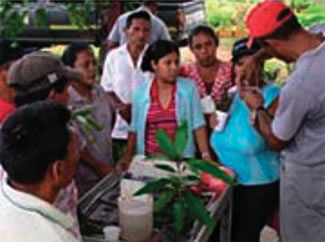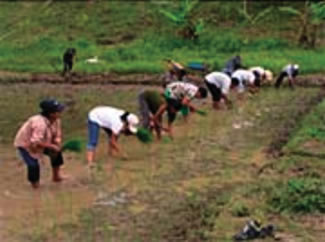Japan's Official Development Assistance White Paper 2005
Column II-6 Promoting Production Activities Useful for the Preservation of the Panama Canal Basin in Harmony with the Environment

Training provided for farmers (Photo: JICA)
The Panama Canal (total length: 80 kilometers) contributes not only to the economy of Panama alone, but also to the global sea distribution. In the center of the canal, a lake 26 meters above sea level requires each ship to pass through three levels of flood gates in order to ascend to the level of the lake, and then descend back to sea level. Although these flood gates aid the movement of ships up and down the canal by regulating water levels, the Panama Canal requires a massive water supply. Consequently, it is necessary to protect the tropical rainforest located around the canal in order to secure water resources. However, in recent years, because local residents have been cutting down trees for the purpose of grazing or have continued the practice of slash and burn agriculture, the area of rainforest around the canal has shrunk by half. To protect the rainforest, it is certain that the tree-planting project is effective. But, at the same time, the method of slash and burn agriculture, which originally causes the depletion of water resources in the canal basin, must be also changed over as soon as possible to another method which could help protect the canal basin.
After the United States and China, Japan is the third highest user of the Panama Canal. Therefore, the continued proper functioning of the Panama Canal is indispensable for the operation of Japanese ships and vessels. Based on this background, Japan implemented the "Panama Canal Basic Preservation Project" beginning in the fall of 2000 through joint cooperation with the government of Panama.
This project aims mainly to provide guidance and promote dissemination of technology (specifically "agroforestry 1 " for carrying out sustainable production activities that also take into consideration the preservation of the natural environment. Approximately 90% of households in the target region are comprised of small-scale farmers who suffer from poverty and lack basic infrastructures such as electricity and sewage systems. Completely occupied with their daily lives, residents do not have a chance to acquire appropriate technologies and knowledge on sustainable production activities. Against this background, they continue the long-practiced slash and burn agriculture.

Techniques for replacing burnt fields with new rice paddies (Photo: JICA)
In order to implement the guidance and dissemination of technology effectively, as well as to provide effective assistance for the capacity building of farmers and sustainable production activities, this project adopts a thorough participatory method. Specifically, Japan supports the establishment of farmer groups and organizations. These groups hold regular meetings and decide on what they want and ought to do to improve their lives. Furthermore, the farmers are taking initiative to hold workshops and, by group, to formulate annual work plans for production activities, including time tables for sowing and harvesting, and off-season manufacturing of processed goods. Through such efforts, crop productivity has increased. In some successful cases, cash income has risen by selling surplus crops and processed goods.
Through such activities, major progress has been observed in the area of capacity building for the farmers. For example, a female farmer who previously would not even say her name in front of a crowd now confidently speaks of her future plans and hopes. In the future, such farmers are expected to play a major role in making significant contributions to the environmental preservation of the canal basin, as well as the sustainable administration of the Panama Canal.


 Next Page
Next Page